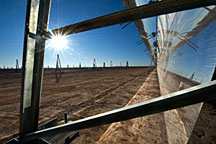- Number 358 |
- March 12, 2012
Thermal storage gets more solar on the grid

Light is reflected in a 25-foot-wide,
500-foot-long, and 10-foot-high
parabolic trough collector at
Abengoa's Solana Plant near
Gila Bend, Ariz.
New analysis at DOE's National Renewable Energy Laboratory (NREL) has found that concentrating solar power (CSP), with its greater grid flexibility and ability to store energy for as long as 15 hours, can enhance total solar power generation and actually give photovoltaic (PV) systems a greater presence on the grid.
When the blazing summer sun starts descending in the late afternoon, rooftop solar panels lose some of their juice. The angles are wrong to capture the photons and turn them into electricity – and the backyard trees are more apt to get in the way.
What is an environmentally conscious — but air-conditioning-loving — homeowner to do?
Peak demand for electricity in the United States typically hits between 4 p.m. and 8 p.m., , but in summer people tend to need air conditioning during the dinner hour and beyond, when kitchen appliances are whirring, lights are on, and TVs are blaring.
To the rescue comes CSP, a technology being tested and deployed by utilities in America's deserts and southern Spain.
PV panels convert photons from the sun directly into electrons for electricity — and are grabbing real estate on rooftops across the Americas, Europe, and Asia.
CSP technologies use mirrors to reflect and concentrate sunlight onto receivers that collect the sun's heat. This thermal energy can then be used to drive a steam turbine that produces electricity for utilities.
Think of power from PV as a roller coaster of highs and lows, and power from CSP, via thermal energy storage, as a gently rolling train, said Paul Denholm, co-author with Mark Mehos of the study "Enabling Greater Penetration of Solar Power via Use of CSP with Thermal Energy Storage."
PV panels and wind turbines contribute electricity to the grid, but without the ability to store that power, they cannot supply the grid after the sun sets, or after the wind dies.
Large fossil-fueled and nuclear power plants can't be quickly stopped or started to accommodate variable energy sources such as solar and wind energy.
CSP can even out these ebbs and flows because it can store power and ramp up output when the amount of direct wind or solar power drops.
"It all gets down to grid flexibility," Denholm said. "What sets of grid technologies do you deploy to make the grid respond faster and over a greater range to the input of variable energy such as solar and wind?
"If you can't respond quickly, you end up potentially throwing away wind and solar energy.
The greatest potential for CSP — and for CSP helping PV to expand its role on the grid — is its capacity to store the energy it captures from the sun for several hours, making it a source of reliable energy after the sun sets.
"CSP can fill in that gap in the evening when there's peak demand for electricity," Denholm said. "Together, the solar resource can provide all that peak demand. And together they can reduce or eliminate the need to build new power plants for those peak periods."
Thermal energy storage at CSP plants "is low-cost because it's not exotic," Denholm said. "It's some large tanks with some media to store energy before you use it to boil the water." The best medium for storage available today is molten salt, NREL's Greg Glatzmaier said.
At a typical molten-salt CSP plant, the salts are stored in two tanks, one much hotter than the other.
The salt is pumped from the "cold" tank to the power tower, where it collects the solar energy that's focused on the receiver, raising its average temperature. The salts then descend into the "hot" tank, where they can maintain this very hot temperature for several days, though typically they are used within hours.
The salt in the hot tank is then sent to a heat exchanger that generates the steam needed to turn the turbines at a power plant. The turbines generate electricity that goes to homes and businesses.
Abengoa Solar is building a 250-megawatt CSP plant near Gila Bend, Ariz.,that will cover 1,900 acres and use 900,000 mirrors to direct sunlight to heat a working fluid inside its tubes. The plant's six hours of thermal storage mean it can deliver electricity after the sun sets to approximately 70,000 homes.
SolarReserve is building the 110-megawatt Crescent Dunes Solar Energy Project near Tonopah, Nev., which will use molten salt to store the sun's energy as heat for several hours. It will include more than 17,000 mirrors to focus the sun's light on a tower 640 feet high.
The cost of PV has been plummeting, and it has a cost advantage over CSP. But CSP has the advantage of storage, and so teamed with PV can improve the benefits and bottom lines of both technologies.
[Bill Scanlon, 303.275.4051,
William.scanlon@nrel.gov]
